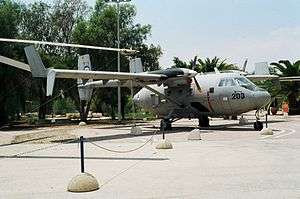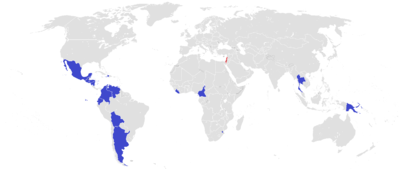IAI Arava
| Arava | |
|---|---|
 | |
| IAI Arava at the Israeli Air Force Museum | |
| Role | Transport |
| Manufacturer | Israeli Aircraft Industries |
| First flight | 27 November 1969 |
| Status | Active |
| Primary users | Israeli Air Force 14 other militaries |
| Produced | 1972–1988 |
| Number built | 103 |
| Unit cost |
$450,000 (U.S.) in 1971 |
The Israeli Aircraft Industries Arava (Hebrew: עֲרָבָה, "Willow" or "Steppe" of "Desert", named after the Aravah of the Jordan Rift Valley) is a light STOL utility transport aircraft built in Israel by IAI in the late 1960s.
The Arava was IAI's first major aircraft design to enter production. It was intended both for the military and civil market, but the aircraft was only built in relatively small numbers. The customers were found mainly in third world countries, especially in Central and South America as well as Swaziland and Thailand.
Design and development
The design work on the Arava began in 1965, and the design objectives included STOL performance, the ability to operate from rough strips and carry 20 passengers or bulky payloads.[1] To achieve this, the Arava design was of a relatively unusual configuration.
The Arava's fuselage was barrel-like, short but wide, and the rear of the fuselage was hinged and could swing open for easy loading and unloading. Its wingspan was long and the twin tails were mounted on booms that ran from the engine nacelles. It was fitted with a fixed nosewheel undercarriage to save weight, while the chosen powerplant was two 715 eshp (533 kW) Pratt & Whitney Canada PT6A-27 turboprops.[2]
The first prototype Arava made its maiden flight on November 27, 1969. The second prototype was destroyed when a wing strut experienced flutter and failed during flight testing on November 19, 1970.[3] The third prototype flew for the first time on May 8, 1971.[3][4] Three aircraft were commandeered for use by Squadron 122 in the Yom Kippur War,[5][6] but were returned afterwards. The Israeli Air Force did not purchase the aircraft until 1983, when nine aircraft were bought.[5] Production ended in 1988. 103 aircraft were produced,[5] including 70 for the military market. The IAF decided in 2004 to retire the aircraft.[5] It is still in operation in some countries.
Variants
- IAI 101 - Civil-transport version
- IAI 102 - Civil passenger aircraft for up to 20 people in airline-standard configuration or up to 12 passengers in VIP configuration
- IAI 102B - Civil transport version
- IAI 201 - Military transport version
- IAI 202 - Modified, longer version with modified wings
The military version could also be equipped with a range of weapons, in order to act in anti-submarine- or gunship roles. The weapon configuration could include two machine guns in fuselage side packs (usually 0.5" Browning), plus a third gun on the rear fuselage, and two pods containing 6 x 82 mm rocket pods or torpedoes or sonar buoys on the fuselage sides.
Another less known military version is the 202B Electronic warfare model. This version was made in small numbers, and had distinct large radomes at each end of the fuselage. The radomes contained the Electronic Warfare mission systems.
Operators

- Gobierno de Tierra Del Fuego - Dirección Provincial de Aeronáutica
- Bolivian Air Force - Six purchased 1975–76. One seized by Nicaragua during delivery, one in use 1987.[7]
- Colombian Air Force - One in operation, FAC1952.[8] 2 out of the original 3 have been retired.[9]
- Ecuadorian Army - 2 in use as of March 2016. One other aircraft E-206 was written off due to a crash[10]
- Ecuadorian Navy - Former operator.
- Air Force of El Salvador - 3 in use as of December 2015.[10]
- Guatemalan Air Force - 1 in use as of December 2015.[11]
- Honduran Air Force - 1 in use as of December 2015.[11]
- Papua New Guinea Defence Force - 3 in use as of December 2015.[12]
- Royal Thai Air Force - 3 delivered from 1981.[13] 2 remain in use as of December 2015.[14]
- Army of Venezuela - 11 in use as of December 2015.[15]
- Venezuelan National Guard
- Venezuelan Navy - Former operator.
Specifications (IAI 201)

Data from Jane's All The World's Aircraft 1982-83.[16]
General characteristics
- Crew: 2
- Capacity:
- 24 fully equipped troops or
- 16 paratroopers
- Payload: 2,351 kg (5,184 lb)
- Length: 12.69 m (41 ft 6 in)
- Wingspan: 20.96 m (68 ft 9 in)
- Height: 5.21 m (17 ft 1 in)
- Wing area: 43.68 m² (470.2 ft2)
- Empty weight: 3,999 kg (8,816 lb)
- Max. takeoff weight: 6,804 kg (15,000 lb)
- Powerplant: 2 × Pratt & Whitney Canada PT6A-34 turboprops, 559 kW (750 shp) each
Performance
- Maximum speed: 326 km/h (176 knots, 202 mph) at 3,050 m (10,000 ft)
- Cruise speed: 319 km/h (172 knots, 198 mph) at 3,050 m (10,000 ft)
- Stall speed: 115 km/h (62 knots, 71.5 mph)) flaps down
- Range: 1,056 km (570 nmi, 656 mi) max fuel
- Service ceiling: 7,620 m (25,000 ft)
- Rate of climb: 6.6 m/s (1,290 ft/min)
See also
- Aircraft of comparable role, configuration and era
- Antonov An-28
- CASA C-212
- de Havilland Canada DHC-6 Twin Otter
- Gotha Go 244
- Miles Aerovan
- Nord Noratlas
- PZL M-28
- Shorts SC.7 Skyvan
References
| Wikimedia Commons has media related to IAI Arava. |
- ↑ Cohen 1974, p. 57.
- ↑ Cohen 1974, pp. 57, 59.
- 1 2 Cohen 1974, p. 59.
- ↑ Air Progress: 22. October 1971. Missing or empty
|title=(help) - 1 2 3 4 John Pike. "IAI-201 Arava". Retrieved 6 February 2015.
- ↑ "122 Squadron - The Dakota". Globalsecurity.org.
- ↑ Siegrist 1987, p. 176.
- ↑ "Photos: Israel Aircraft Industries IAI-201 Arava Aircraft Pictures - Airliners.net". Retrieved 6 February 2015.
- ↑ WebInfomil. "IAI ARAVA 201". Retrieved 6 February 2015.
- 1 2 Hoyle 2015, p. 37.
- 1 2 Hoyle 2015, p. 39.
- ↑ Hoyle 2015, p. 45.
- ↑ Pocock 1986, p. 115.
- ↑ Hoyle 2015, p. 50.
- ↑ Hoyle 2015, p. 53.
- ↑ Taylor 1982, pp. 123–124.
- Cohen, Irvine J. "Arava: Israel's first-born bids for world market". Air Enthusiast International, February 1974, Vol 6, No 2. pp. 55–61, 92–93.
- Hoyle, Craig. "World Air Forces 2015". Flight International, 8–14 December 2015, Vol. 188, No. 5517. pp. 26–53. ISSN 0015-3710.
- Pocock, Chris. "Thailand Hones its Air Forces". Air International, Vol. 31, No. 3, September 1986. pp. 113–121, 168. ISSN 0306-5634.
- Siegrist, Martin. "Bolivian Air Power — Seventy Years On". Air International, Vol. 33, No. 4, October 1987. pp. 170–176, 194. ISSN 0306-5634.
- Taylor, John W. R. Jane's All The World's Aircraft 1982-83. London:Jane's Yearbooks, 1982. ISBN 0-7106-0748-2.